

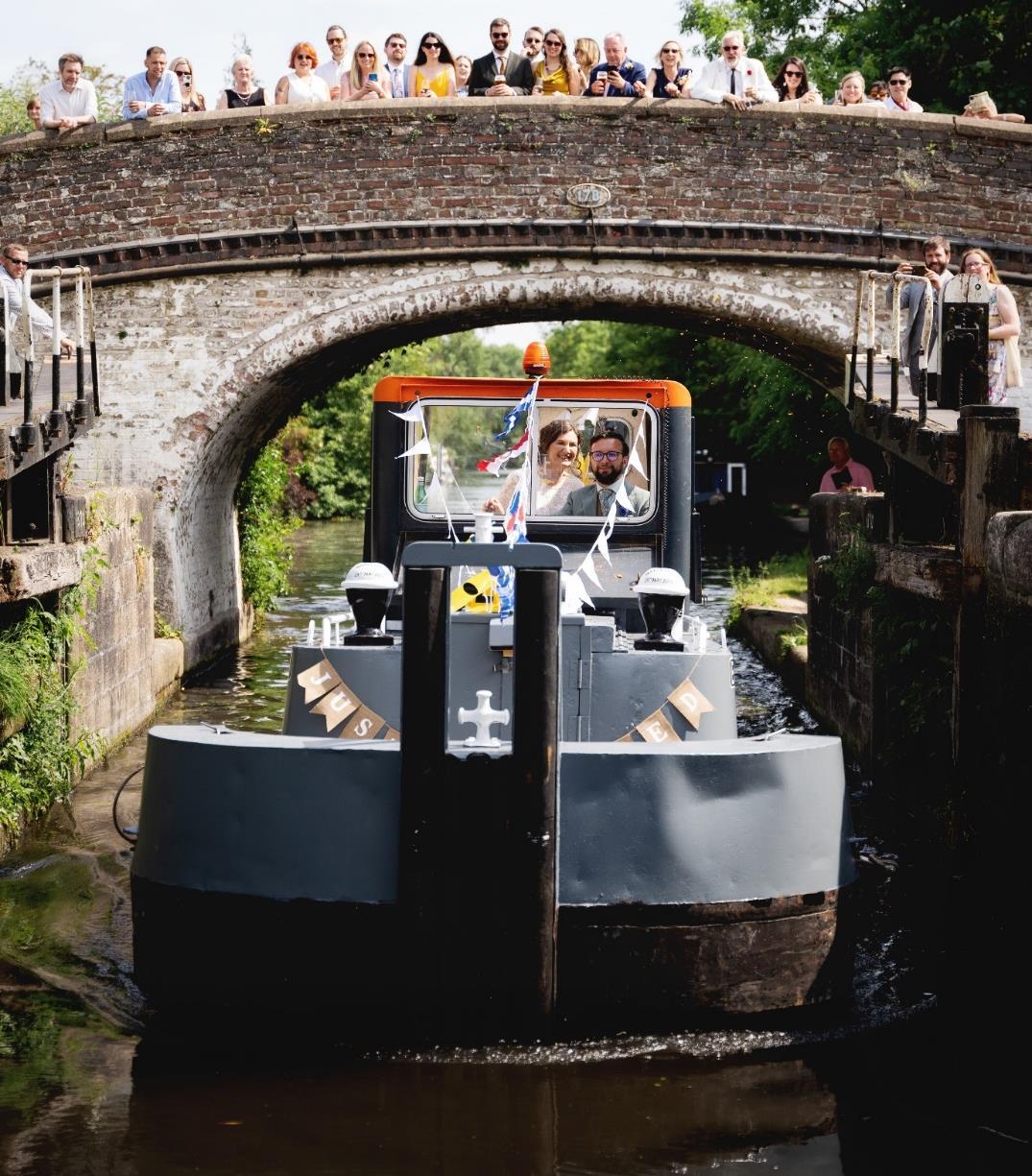
From the Chairman

As I write my inaugural report as Chairman of the CBOA, I wish to extend my sincere appreciation to David Lowe for his outstanding leadership over the past decade. David's extensive knowledge and expertise, particularly concerning the northern waterways, serve as a benchmark for me as I assume this new role. His ongoing involvement with the committee ensures that we will continue to benefit from his invaluable insights.
My professional background in the waterways industry is rooted in my role as Commercial Manager for Wood Hall & Heward, based in London. In this capacity, I oversee a diverse fleet of over 60 vessels, providing support for civil engineering projects, waterway maintenance and freight transportation This experience means I have a good understanding of the south but will remain reliant on David’s knowledge of the northern waterways My lack of experience with the northern waterways is something I am keen to gain familiarity with during my time as chairman. To this end I welcome any opportunity to get out on these waterways with our trade members I’m especially keen to get a local perspective on current commercial operations as well as challenges, and aspirations for the future If any operators would be willing to host a visit, please reach out to me at Lee.Wilshire@cboa.org.uk
While considering how to start this report I thought it useful to start in the past, delving into the archives at WHH I managed to find the Spring-Summer newsletter from 2013 and David's first report as chairman, and to review how things have developed.
David paid tribute to Louise Sliwinski at Robert Wynn & Sons for her work looking after membership affairs This strangely was echoed in one of my first acts as chairman which was to thank Louise for her continued support behind the scenes over the intervening 10 years. Unfortunately, for the committee at least, the reason for this was Louise’s imminent retirement from Robert Wynn & Sons The committee and I hope Louise is now settling into her retirement and we wish her all the best.
David's report highlighted the recent approval of the Leeds Natural Resources Plan, which included provisions aimed at safeguarding crucial wharfs such as Knostrop. It's heartening to note that, through David's efforts and those of others, Knostrop finally received its first shipment of sea-dredged sand in 2020, seven years after the plan's approval. Discussions now focus on enhancing freight traffic along the Aire & Calder, but the conversation has shifted from 'if' to 'how'.
At the time of David’s report in 2013 CRT was a fledgling organisation having recently been created from British Waterways David sat on a number of the advisory groups with CRT, something I also do with my involvement with CRT’s Navigation Advisory Group. CRT is once again in a position of uncertainty with a reduction in future government funding matched against a network increasingly challenged by climate change.
More positively in 2024 there seems to be growing understanding that waterways can play a key part of a modern low carbon logistics network. In recent months CBOA has been having a number of conversations with government organisations to try and explain the nuances of our industry to the policy makers. Of particular note has been the DfT Call for Evidence on the review of Modal Shift Revenue Support (MSRS) grant funding (see more about this on page 4). This funding has worked well for rail but has made little to no headway for the inland marine sector and the review would hopefully seek to rebalance things to better support our sector Our vice chairman Tim West has done a fantastic job drafting the CBOA response and liaising extensively with other organisations to make sure the views of our sector are put across to the DfT in a clear and organised manner. We await with interest the DfT’s feedback and next stage of the review.
We welcome the new appointment of Andy Rothen of A&R Rothen Ltd., as East Midlands CBOA Representative. With his company’s experience of over 40 years of waterway contract work with a variety of vessels, capable of all kinds of activity, we are pleased that he is able to take on this role covering the east midlands area. Andy was a founder member of the CBOA’s predecessor organisation, the CNOA.
I’m looking forward to my time as chairman and hopefully the opportunity to meet some of you in person, online or even on the water at some point soon!
Lee WilshireDFT grant review
The freight grant system has been a hot topic for the inland waterway freight carrying community for years. Whilst not all members will be familiar with it in its current form, most will remember the previous Freight Facilities Grant scheme (FFG) which was withdrawn over a decade ago.
The FFG enabled several freight projects which may not have happened otherwise, some of these being:
• capital equipment including barges for the aggregate traffic from Denham to Stockley Park, West London to be funded and set up for the 7-year contract, commencing in 2003
• Handling equipment at the wharves on the River Severn for Cemex, and refurbishment of 2 barges for CBOA member Thompson River Transport, still operating today
• Whitwood Wharf and barges for Lafarge and CBOA member Branford Barge Owners in Yorkshire
• Barges and handling equipment for KD Marine
• Design and construction of Terra Marique and refurbishment of Inland Navigator for CBOA member Robert Wynn & Sons; both vessels are still operating today.
As part of this review the Government has opened a “Call for Evidence” and is seeking views on the current mode shift grant schemes. The primary objective of this call for evidence is to seek information about the experience of those who are using Modal Shift Revenue Support (MSRS) and Waterborne Freight Grant (WFG) or alternative schemes. These schemes, which provide vital support for the freight industry, are expiring on 31 March 2025 and 31 March 2026 respectively.
The DfT were asking for feedback from those who have used the schemes and those who considered applying but decided not to. Further information can be found here https://www.gov.uk/government/calls-for-evidence/mode-shift-grants-review/mode-shiftgrants-review#full-list-of-questions
The DfT is currently exploring the following options:
• option 1: closing the 2 freight grants schemes
• option 2: continuing the schemes as they are with necessary modifications to meet the requirements of the UK’s domestic subsidy control regime
• option 3: as option 2, but with additional changes
• option 4: replacing the current schemes
The response form asked for feedback relating to:
• Ease of the application process
• Promotion of the scheme
• The supporting evidence required
• What challenges, if any, did you encounter when applying for, or when part of the scheme?
We very much welcomed input and thoughts from CBOA members on the questions posed above, as well as any thoughts and suggestions with regard to a different way of supporting modal shift to water.
CBOA Vice Chairman Tim West was coordinating responses from members The call for evidence was open until the 2nd February 2024. We will follow up with news on this from the DfT when available. We have campaigned for and hope for an improved deal in future which adequately supports the capital expenditure and the setting up of new traffics.
DfT review on HGV emissions and future zero emission
Around 80% of the 200 billion tonne kilometres in 2022 of freight moved around the UK is carried on trucks, so report the DfT. This produced about 20% of all the UK’s domestic transport greenhouse gas emissions. Acknowledging that there is still some way to go before battery or hydrogen fuel cell HGVs can deliver the practicality of a diesel HGV, they advise that development for this is in hand.
In November 2021, the government confirmed its intention to end the sale of new non-zero emission HGVs less than 26 tonnes by 2035, with all new HGVs sold to be fully zero emission at the exhaust by 2040. A strategy for HGV and coach infrastructure is due for publication this year.
Whatever the propulsion means, the lorry uses far more energy per tonne/mile than water or rail, and so there is still a need for more modal shift wherever this is possible to both means. The zero-emission drive also ignores the other pollutants/particulates –tyre wear, brake dust and also road wear which are a significant issue, almost as much as exhaust emissions.
More Ross Barlow developments
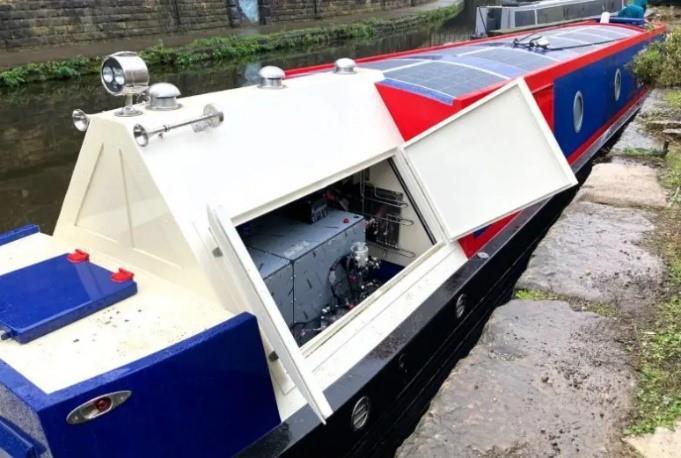
CBOA News has reported previously on the late Prof. Rex Harris’ development work using hydrogen cells to generate electricity to power the 57ft narrow boat, Ross Barlow His colleague Allan Walton (Professor of Critical and Magnetic Materials, University of Birmingham) had applied for and won a government grant to install new batteries in the Ross Barlow, which has been removed from the university site and is currently being re-hulled in a boatyard in Stafford.
Use of hydrogen means that no carbon dioxide is released during operation. The hydrogen is stored in the form of a metal hydride – an inert powder, and so is apparently safe It is reported that Bramble Energy working with custom engine builder Barrus was awarded Government funding from BEIS, now the Department for Energy Security and Net Zero (DESNZ), of just under £1 million to develop its hydrogen fuel cell technology as a solution to replace diesel engines in boats, potentially saving 12 tonnes of CO2 annually per vessel, as quoted. Presumably this is based on some form of an average pleasure boat usage; development of this for freight use on and inland waterways we believe is awaited.
The next phase is a testing programme on the UK inland waterways with data collected helping Bramble to develop future marine Printed Circuit Board Fuel Cell (PCBFC™) technology. This can be manufactured in almost any size or arrangement cheaply using existing PCB manufacturing technology.
Several years ago, we were fortunate to have Prof. Rex Harris give us a presentation at a CBOA AGM on his hydrogen power development.
Lorry Driving hazards
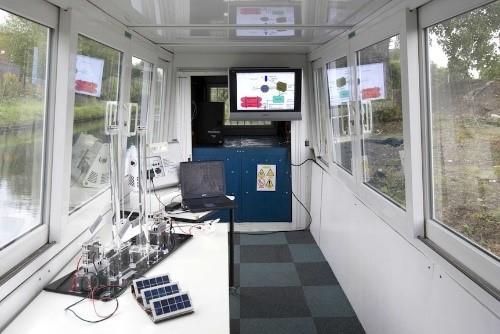
“A combination of health problems, an ageing workforce and a failure to recruit younger workers, is creating a crisis in HGV drivers creating severe skills shortages, which will damage the overall health of the economy” warns Unite, the UK’s largest union.
Many EU long distance lorry drivers did not return to work in the UK after Brexit and British people are not coming forward to train for this work. Understandably, the young and middle-aged are not coming forward to train for this currently hazardous and unhealthy occupation.
It is said that in middle age, leg and knee problems and heart problems become evident; lack of exercise and briefly snatched unwholesome snack meals are quoted as contributory reasons. In short, musculoskeletal disorders, poor diet and stress take their toll. The government’s Health and Safety Executive reports that levels of injury and ill-health are high in the transportation and storage sector, demonstrated by a comprehensive set of figures.
Perhaps there is scope here for better promotion of water freight, with its considerably better environment and lifestyle? Long hours at the helm have to be far healthier than the stress and problems with driving. Some exercise at locks is all to the good, even if just getting off onto the lockside to handle lines and press buttons!
CRT Impact Report
CR have issued their 2024 Impact Report, following on from the November 2022, ‘Valuing Our Waterways – Aggregate Benefits to Society and the Economy’. As CRT scoped, this impact report seeks to bring to life the stories and testimonies, partnerships and projects that sit behind the monetary values set out in the 2022 document. CRT say it is to demonstrate the full breadth of societal benefits being delivered and the richness added to people’s lives by their network providing health, wellbeing, happiness and engagement of people in waterways, particularly young people.
It is pleasing to see that the report also covers freight as a sustainable transport method, larger waterways able to take many lorries off the roads, with a quote from CBOA vice Chairman Tim West, “Moving freight by water makes economic and environmental sense. Our inland waterways connect many large centres of population to each other as well as those conurbations to many major UK ports. Waterborne freight carriage reduces the environmental impact of emissions, noise and the economic costs of congestion and accidents. However, the current tonnages carried are just a small amount when you consider the tonnages that could be moved on our inland waterways if they were to realise their freight carrying potential.”
The inland port of Leeds is featured, as well as the Sheffield and south Yorkshire navigation (SSYN) carrying oil on the Exol Pride to Rotherham, and the sand traffic on the River Severn is also covered. All articles show pictures of barge operation and give the tonnages carried and the numbers of lorry trips saved, greatly reducing road wear and hazard, particulate emissions and of course reduction of CO2 emissions. This is not a complete round up on the inland water traffic in the UK as it is only that carried on CRT’s waters, but it does very well demonstrate the cause and fits overall with the benefit that CRT also provide with leisure and wellbeing etc. CBOA has been promoting this for some time and insufficient notice is taken of inland waterways for both the social, environmental and economic benefits they provide for carrying freight.
Riparian owner moorings case
In most cases the bed of a river is jointly owned by the landowners either side, the centre being thought of as the property boundary. However, there are some places where a riparian owner does not own half the river bed.
In the recent court case of EA v Casey, the judgement was made that where the land owners do not own the bed, they cannot allow mooring to the bank for more than 24 hours. The owners of the bed (CRT, EA or other navigation authority) then have the right to charge a mooring fee, the vessel being on their land.
There are instances where barges are moored on private (non-EA or other) wharves and until now no charge could be legally levied by the navigation authority. Our understanding is that the case determination could change this, allowing the navigation authority to view mooring as trespass, where it owns the bed.
The situation on canals is different as in nearly all instances the land was purchased for the building of the canal and so the navigation authority today owns the whole bed.
Regional News
Highlights of recent traffic enquiries
David Lowe has kindly provided the following:
North West
We are pursuing the potential for movement of salt on the Weaver/Ship Canal with Peel Ports who appear enthusiastic about increasing barge movements generally, especially if the grant regime is enhanced.
There is interest in moving dredged material from the dredger Admiral Day at Eastham (Mersey) up to Weaste wharf, Manchester using 1000 tonne dumb barge plus tug. Admiral Day is discharging on the wall at Weston Point. 3000 tonnes/week cement is being shipped to Weaste from Ireland.
North East
Ken Morris, CBOA Freight Rep (North), is in contact with Rainham Steel regarding potential movements of steel from Immingham to the new facility at Althorpe (Keadby). The plant is currently being installed (which has been moved from Flixborough) and Rainham are keen to start moving material once the plant is up and running.
The Canal and River Trust reports on the potential to move substantial tonnages of dredged material from the CRT dredging tip at Trent Port (between Torksey and Gainsborough) down to possibly Beckingham wharf (Gainsborough). Several craft will be needed for this
The proposed Birkwood quarry (Stanley Ferry): wharf design is still being discussed with CRT. Movement destinations are not yet firmed up but a planning permission restriction means that all material must be moved out of the site by barge. This latter point is where planning control can have a definite positive effect with the avoidance of environmental issues locally if lorry transport had been permitted.
Port Leeds, Stourton: discussions between the parties continue well. Full planning permission for the wharf and site will be needed. We understand the planners are supportive, discussions continue on funding with the West Yorks Combined Authority.
Hull: CBOA member Mainmast continues to move liquid cargoes within Hull docks, and deliveries of base oil to Rotherham with the barge Exol Pride continue albeit not during February due to two concurrent stoppages at Goole Caisson and Long Sandall lock – re-arranged at the request of CBOA through the CRT stoppage sub group on which CBOA is represented. Exol Pride is being docked and repainted etc during this time.
Wakefield: Fastsource Ltd is sited on the former Hargreaves coal loading facility opposite Fall Ing Lock on the Aire & Calder (Wakefield branch). They deal in recycled aggregate but would like to import aggregate by barge for local distribution.
Tarmac, Nosterfield Quarry: North Yorkshire Council has, surprisingly, agreed to an extension of quarrying at this location.
This is disappointing as there was potential for supplying Tarmac’s Whitwood readymix plant (Whitwood wharf) by barge if/when Nosterfield supplies became limited or unavailable.
South East/West Midlands
CBOA has been assisting with two narrow boat enquiries: carriage of farm produce transhipped to narrow boats in London ex Thames sailing barge and carried to Birmingham, and scrap from a large producer in Birmingham to receivers in various locations, the latter to be covered for a TV programme.
The farm produce would be seasonal at summer harvest time (tonnage dependent on the harvest), but it is not scheduled to happen this year unfortunately. The barge owners are also keen to pursue other potential on the estuarial waters
The scrap needs a TV broadcaster to sign up to the project – the two TV companies courted did not take it up for different reasons. The production company are very keen and will pursue possibilities elsewhere.
Estuarial/other
CBOA Chairman Tim West reports on Wynns’ Terra Marique’s operations, but more recently less on the inland waterways:
• Beach landing on Black Rock Sands, North Wales to deliver a 155te electricity transformer loaded in Rotterdam for a substation at Trawsfynydd power station
• Carried 4 transformers from Rotterdam to Pembroke power station
• Carried a small transformer to Le Palais on the small island of Belle-Île-en-Mer, France
• Carried an offshore substation from Immingham to Grangemouth
• Carried a dock crane across Cardiff docks
• Carried a transformer from Ellesmere to Dundee.
The Terra Marique is purpose designed for carrying AILs, getting as close as possible to shore or waterway locations where needed, and can also provide a submersible floating dock facility wherever required
Wynn’s gained the Logistics UK water business of the year in December and also had an original Robert Wynn and Sons steam engine built in 1923, visit the Terra Marique when she was in Immingham
East coast waterways
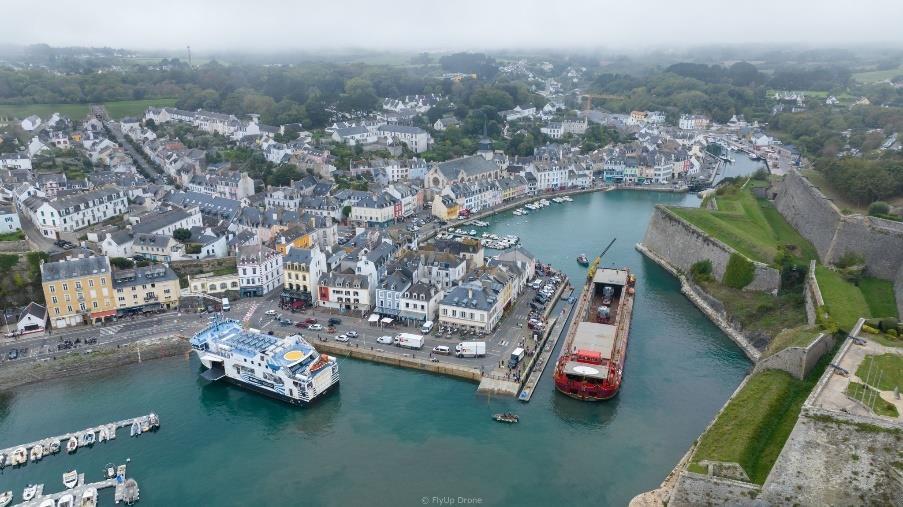
IWA member Robin Adams has kindly written to us to highlight recent traffics on the east coast waterways as follows:
A 176te steam turbine from the manufacturer Howden Turbo of Peterborough was loaded aboard the Liberian flag coaster River Trader, taking it to Antwerp to tranship it to Singapore.
At Kings Lynn grain has been shipped to Buckie in Scotland. From the other side of Scotland at Glensanda, there have been some shipments of granite to Lynn.
At Ipswich a large cargo of your urea fertiliser was landed. Ipswich port on the River Orwell handled over one million tonnes of freight last year.
South East – Wood Hall and Heward Ltd
CBOA Chairman Lee Wilshire has provided the following about the activities of Wood Hall and Heward: 2023 had a number of slightly out of the ordinary jobs for the WHH fleet, from filming stunt scenes for a Netflix drama to coordinating a unique car launch event for Nissan
The latter involved lifting a prototype car onto one of our barges and moving it into position and mooring it up on cue behind the CEO of Nissan, who unveiled it to a crowd of waiting journalists. The fact that the car was “basically priceless”, weighed over 2 tonnes with approximately 1” of ground clearance and was made of clay and delicate to touch, only added to the challenge of the lift. The weather held off and the event was a total success, sadly all being wrapped up in a day as though nothing had ever happened.
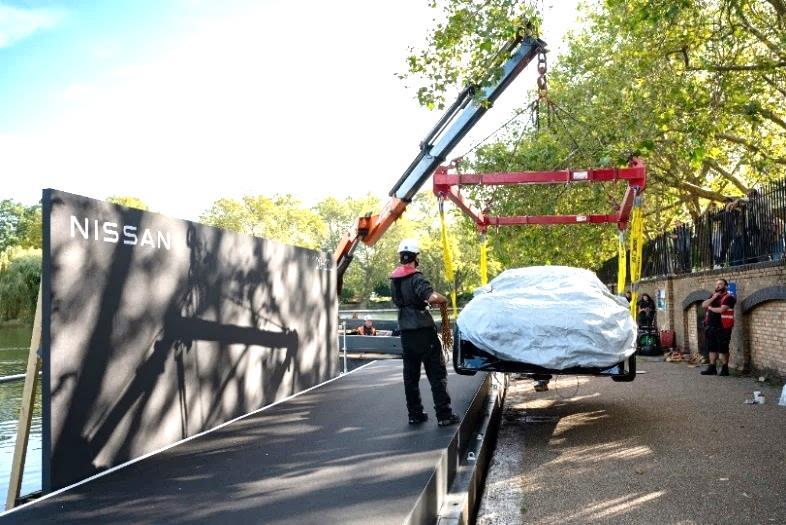
WHH continue to work with iRecycle on the waste traffic from Camden Market to Powerday. iRecycle have managed to significantly increase typical tonnages per barge through use of bag compaction and better management of the loading of the barge within the Market This has been so effective that barge tonnages are nearly at 200% of their previous capacity increasing the cost effectiveness and sustainability benefits of this method of waste management.
Whilst most of WHH involvement with canalside development involves removal of demolition waste or spoil, we have recently had an opportunity to transport materials to a site just west of Paddington for McAleer & Rushe The project is situated down a narrow road and is unable to receive large lorries to the site. We have assisted by receiving artic lorries at our yard on the Paddington Arm in west London (from the port at Purfleet) each with around 20 pallets of bricks that have come from Germany by ferry. The lorries are unloaded using our telehandler and loaded into one of our barges before being pushed to the project site by a tug The bricks are then able to stay in the barge on site and can be unloaded with the site tower crane as and when needed Though this probably hasn’t saved much in terms of road miles, the 13 and counting barge loads we’ve carried have significantly reduced the impact on local roads in the vicinity of the project site. Also, the ability to leave bricks in the barge until needed has saved valuable space and time on a congested development site.
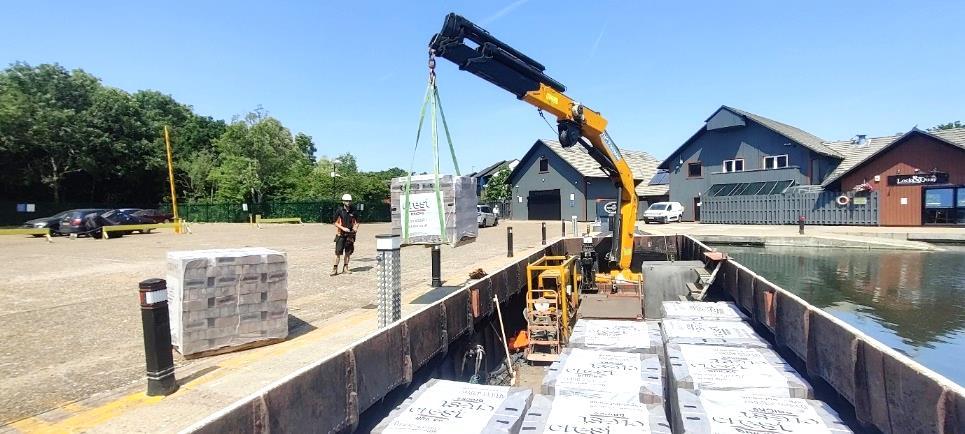
Enduring Chill Winds on the Thames
We also continue to operate our fleet on 100% HVO ensuring that on top of the usual efficiencies of movements by barge, the emissions from the exhaust of our boats are over 90% lower than they might have been on regular diesel.
We are very grateful to John Spencer, Director of CBOA member GPS Marine, for the following detailed summary about his company and operations on the river Thames:
The significant increases in the volume of freight carried on the Thames in recent years was driven by London’s growing requirements for improved infrastructure due to it being a busy and vibrant city This led to a succession of major projects that were required to use the Thames for much of their transport requirements for bulky goods. The Covid pandemic, through its effect on government finances and the dramatic reduction in the number of people travelling to London to work due to people working from home, combined with political decisions to spend what money is available for investment away from the southeast of the UK has led to a significant decline in freight business on the Thames. Following 10 years during which the Crossrail project was followed by the Northern Line Extension, which was followed by the huge Tideway Project, which in turn was followed by the Silvertown Link Project, freight operators and tug owners are having to learn to live without a constant flow of work from major projects absorbing a large proportion of non-passenger vessel capacity on the Thames.
GPS Marine’s directors were concerned about the potential of over capacity on the Thames
This was caused by the increased overall fleet capacity required to service the Tideway project, to drive down rates and create a race to the bottom where companies operating to high standards of safety and maintenance would be driven out by cut price competitors operating to no defined standards such as voluntary ISM. A very significant reduction in overall demand for tugs, towage and freight operations on the Thames was seen as inevitable upon completion of marine works on the Tideway project.
Attempts to bolster demand post the Tideway project by reactivating wharves to facilitate the diversion of freight from road to water were largely unsuccessful, not because the business was not there, but because planning applications have been delayed for years due to the sclerotic UK planning system and the continuous drip feed of spurious objections into the planning process by the Environment Agency. In the case of one wharf, which was already safeguarded under the London plan, a reactivation process started in late 2017 has yet, by mid2024, to generate a single tonne of increased water freight from a safeguarded wharf. During this time, the same wharf’s lack of use has put approximately 2.25 million tonnes of freight that could have been transported by water onto the A102M immediately South of the ever-congested Blackwall Tunnel. This is, apparently not remotely unusual, in the case of another safeguarded wharf, planning and reactivation took 15 years to achieve!!
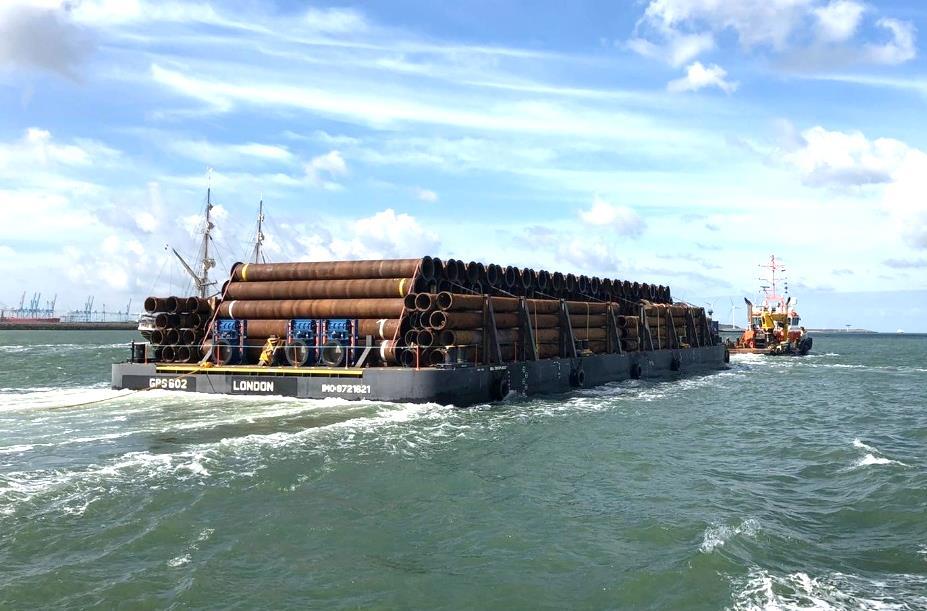
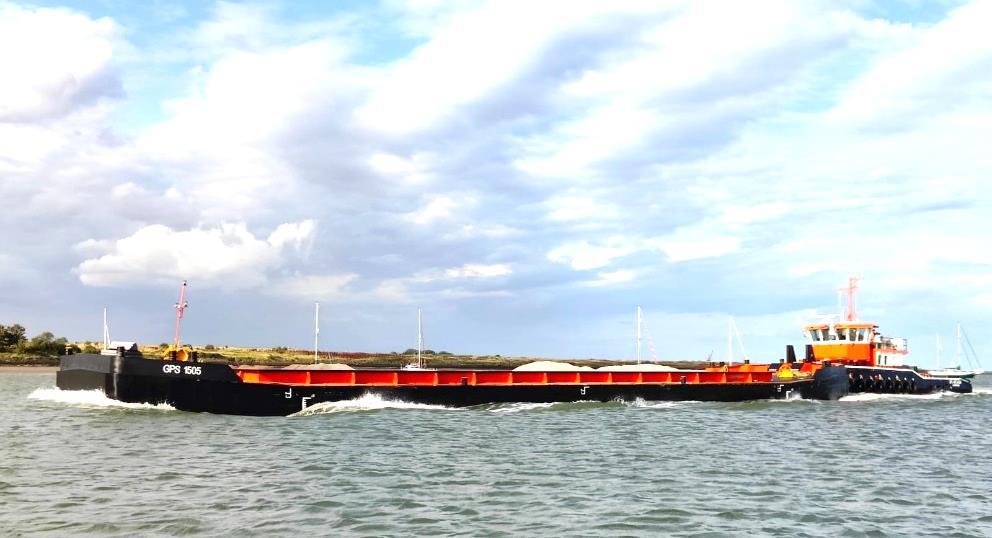
With attempts to reactivate safeguarded wharves proving difficult in the extreme, GPS Marine has sought to maintain a semblance of market equilibrium by restricting vessel supply. To this end, GPS Marine’s investments in new and nearly new craft have focussed entirely on vessels that can be deployed outside the Thames / Medway and UK markets, and GPS Marine has developed a strategic alliance with Landfall Marine Contractors BV, based in Ridderkerk NL, to exploit these craft in markets outside the Thames and Medway, in Europe. In late 2021 the directors of GPS Marine decided to investigate the acquisition of one of the business’ main competitors, Alan C Bennett & Sons Ltd. This acquisition was completed in mid-2022 and delivered much needed additional business and new clients, as well as control over 3 more tugs and 10 more barges, of which 6 of the largest barges were only built in 2018.
Since buying Alan C Bennett and Sons Ltd, GPS Marine has sold the older elements of the Bennett barge fleet out of trade and activated the load line certificates on the remaining 6, 2018 built barges, enabling GPS Marine to begin moving freight from the Thames and Medway to ports in the Thames Estuary which lie outside the Category D waters limit. Since the Alan C Bennett acquisition, GPS Marine has invested over £350,000 in the 2009 built GPS Arcadia (ex Christian), but has disposed of one of the remaining Bennett tugs out of trade, and plans to imminently dispose of the other, which is currently laid up, if an acceptable buyer can be found. Within the GPS Marine tug fleet, one tug has been sold out of trade and another 2 tugs are actively on the market and will immanently be sold either to buyers from outside the area or out of trade. At the time of writing, 50% of GPS Marine’s fleet of 16 tugs are either laid up or consistently operating outside the Thames / Medway or UK markets.
In the barge fleet, older craft have been scrapped if at major surveys they were suspected of being possibly too expensive to repair, and other barges have been semi-permanently taken out of service when they have become due for major surveys, pending an upswing in demand. Where possible craft have been employed outside the local or UK markets, and in Europe.
Combined, these strategies seek to maintain equilibrium in the Thames / Medway market whilst both exploiting opportunities further afield and maintaining overall fleet capacity so as to be able to meet demand if and when there is an upturn in major project activity in the Thames and Medway markets. At the time of writing, of a fleet of 40 barges, having a combined capacity of 53,500 tonnes, 12 barges totalling 20,000 tonnes of capacity are either laid up or employed outside the United Kingdom or Thames and Medway markets.
In addition to attempting to manage the oversupply in the Thames and Medway market, and to offset the effects of reduced major project demand, GPS Marine has developed its marine civil engineering business by establishing GPS Marine & Civil Services Ltd in partnership with two other marine civil engineering businesses. This business has grown strongly since it was established in 2021 and is now a regular charterer of significant elements of GPS Marine’s fleet of tugs, barges and pontoons.
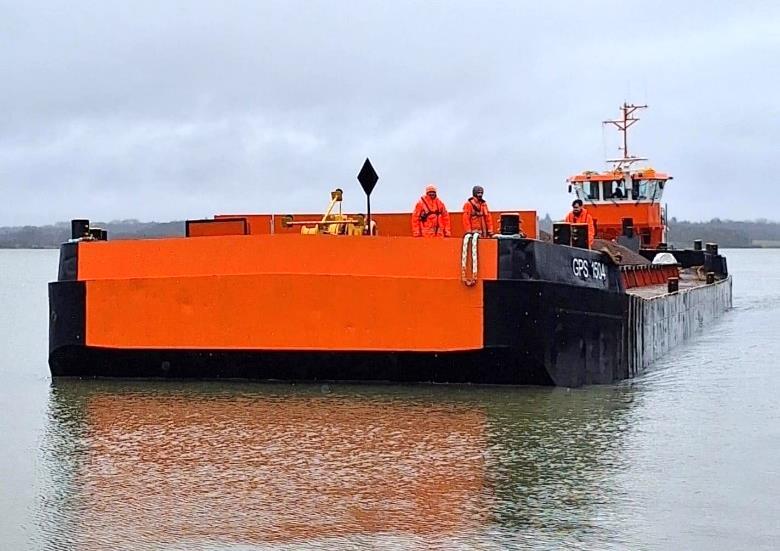
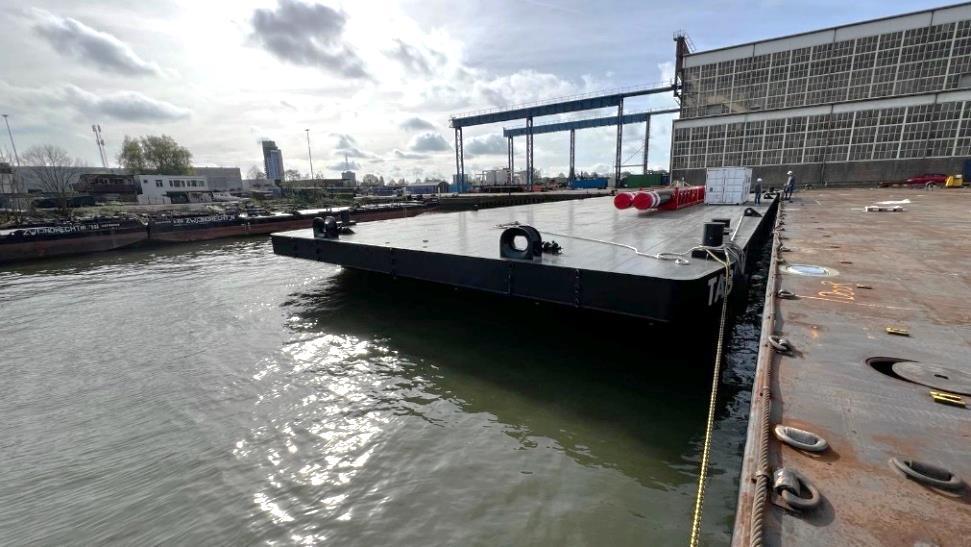
Throughout 2023, and in early 2024, the strategies employed have enabled GPS Marine to constantly operate between seven and nine tugs, transport over 1 million tonnes of cargo on the Thames on an annualised basis, increase GPS Marine’s presence in European markets, reduce the average age of the fleet, and continue to make strategic investments. In 2024 the business has taken over the operation of the slipway and shipyard facilities at Ramsgate and further developed the group’s engineering business. Both these investments were founded in a strong belief that engineering, ship and vessel repair capacity and capability in the southeast of the UK continues to diminish rapidly, and so investments were targeted to reduce reliance on third parties to carry out fleet repair and maintenance. In addition to the foregoing, in April 2024 the business took delivery of a 2024 built 50 x 18.8m seagoing IACS classed pontoon from TAB Marine in Holland, to improve the ability of GPS Marine to support the activities of sister business GPS Marine and Civil Services Ltd. Other strategically important investments for the Group are currently the subject of contractual negotiations with a view to completion later in 2024.
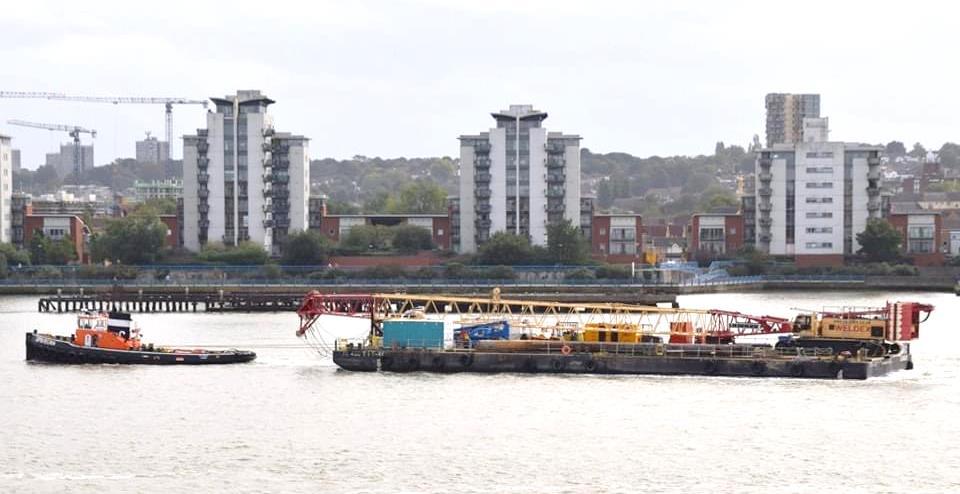
In summary, GPS Marine has only been able to continue to invest and develop its business despite severe challenges in local and national markets by implementing strategies to combat reduced demand for its core business on the Thames. This, caused by the total absence of major projects in the Capital requiring use of the Thames to transport construction related goods, and a completely dysfunctional planning system has prevented the reactivation of safeguarded wharves to facilitate modal shift of London’s freight traffic from road to water. The strategies employed were necessary to limit the over-supply of craft in core markets, retain more of the income generated by the Company’s fleet within the Group, exploit markets beyond the Company’s core area of operation, and create additional demand through the creation of a sizeable business that utilises the Company’s vessels to exploit opportunities in a related market. On the Thames in 2024, it is not enough to be an efficient operator of a large fleet that provides its clients with cost-effective, high-quality freight transport and marine project support. To be successful requires very much more indeed, and the same is probably the case throughout the water freight sector in the UK.
Yorkshire Climate Commission
Yorkshire and Humber Climate Commission is an independent advisory body set up to bring players from the public, private and third sectors together to support and guide ambitious climate actions across the region. It supports rapid progress towards net zero carbon emissions via inclusive transition, promoting sustainability and climate actions that also protect nature and biodiversity.
The Commission reports that the climate crisis with transport emission is now the largest single source of carbon emissions, and one which is still rising, mainly driven by rising car ownership and usage. In 2023 national emissions were now back at 99% of pre-Covid levels, presumably still rising with the steady increase in car ownership, the emissions figures being 80% for rail and 90% for buses The Commission seeks to put modal switch and above all investment in rail and waterways infrastructure at the top of its agenda, and persuade local authorities and government agencies to switch investment away from road building and airport expansion towards rail, bus, waterways and cycling
In addition to personal transport the Policy Team at Leeds University aims to consider rail and waterway freight connectivity and transhipment sites as well as rail re-openings, electrification, as well as Light Rail Transport investment, to also influence regional and local transport and development policies
CBOA previous Chairman David Lowe has offered to enhance the presentation to Yorkshire County Council presenting how Yorkshire waterways can be better utilised for freight carriage.
Transport for the North – Strategic Transport Plan
The second Strategic Transport Plan (STP) from TfN as summarised “…outlines how with the right investment and policy levers, together with transformational transport infrastructure we could have a Northern economy that will be £118 billion larger by 2050” and “…how better connectivity can enable economic growth, decarbonise our transport system and create more opportunities for all.”
Reviewed by CBOA officers and acknowledging that it effectively sits above TfN’s Freight Strategy and so has a broad focus and is therefore light on specifics, it is however relatively scant on water freight; the SSYN, the Ouse, the Weaver and the Trent getting little or no mention.
However, waterways are mentioned on page 91 – Strategic outcomes required for our freight network, “Maximising the utilisation of our rail and inland waterway networks, improving multimodal connectivity and local distribution hubs to improve efficiency, and encouraging modal shift from road to rail/water, to support decarbonisation and improved air quality”
Unfortunately, the required actions by TfN on pages 125 & 126 do not contain waterway references. However, this is seen as something that CBOA can engage and follow up with TfN, confident that implementation with waterways will be better addressed.
In the press
Peruvian Wharf
This wharf at Silvertown on the Thames estuary, was safeguarded by the government under a scheme to prevent developers from construction on selected wharves. The wharf was used three times during September and October for inbound aggregates from Calais, reported the magazine Coastal Shipping. Without this protection it would have now seen construction and would no longer be available for shipping. The benefits of wharf protection are clearly demonstrated, as has been covered in previous issues of CBOA News.
Caledonian Canal
The Editor of Coastal Shipping magazine praised the “innovation” and “environmentally friendly” transport method of transporting timber from the inaccessible shores of Loch Arkaig, by the Woodland Trust and providing them with valuable revenue.
The forest then being returned to a natural state and restoring habitats for native species. The Editor thought very well of the scheme to use the canal in this way.
North east wharves
Coastal Shipping magazine reported a high usage of Trent and other inland wharves, notably on the Trent at Flixborough wharf and at Groveport and Keadby wharves upstream During 2023 a total of 384 coasters called on the Trent wharves.
The single wharf, Kingsferry wharf at Burton Stather was mentioned as having being purchased by MCL Solutions Ltd with a view to re-using it for freight. Some work has been done on the wharf with a crane removal and mobile crane replacement and other handling equipment, but Coastal Shipping report that there is some local opposition to its use as the road goes through the village. Perhaps a solution is needed to avoid this conflict of interest/use and eliminate HGV use of the village street. Apparently, this wharf has seen little use over the last 15 or so years, but www.shipspotting.com reports the sighting of the coaster Klausen discharging a bagged cargo recently on April 15th . Coastal Shipping mentioned Howendyke on the river Ouse for several cargoes, as was Goole with 66 ships during January and February
Cory barges to carry heat
CBOA member Cory recently posted on LinkedIn that they are partnering with Sheen Parkside and Sunamp to form the Thames Mobile Heat Consortium. The objective is to decarbonise heating by using waste heat that will be transported via thermal batteries. Starting initially from Cory’s Riverside energy from waste plant, the heat will be carried in thermal batteries to the heat consumers, or the so-called district heat networks.
In addition to reducing the dependence on gas and decarbonising heating, it also reduces the dependence on electricity during peak times, so reducing peak loads on the generators and balancing the demand.
Overseas News
Three Gorges Dam and locks
The river Yangtze in China lays claim to be the longest river flowing within one country. Use of it for freight is extensive with barges carrying oil, various dry goods, aggregates and ro-ro lorry freight. Strangely, nearly all dry cargoes, of whatever type are sheeted over (sometimes not very well it appears), either within the hold or over the coamings. The design of vessels appears visually a cross between an inland barge and a coaster, often with a tall bridge at the stern, appearing somewhat ship-like. No low bridges exist.
The three Gorges were a major impediment for freight accessing the middle and upper Yangtze, until the construction of the dam and bypass locks, from 1994 until completion in 2006

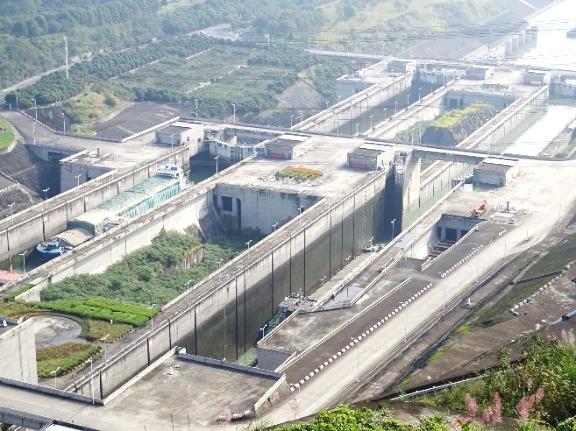
The dam is a 2,309m straight dam providing nearly 46m head of water, placed directly across the river, the installed generating capacity 22,500MW as built, with a stated design annual capacity of 88.2 billion kWh The two parallel sets of five-rise locks and access canals are cut into the northern hillside, the whole being a massive feat of engineering. In addition to the two staircase five-rises, there is a boat lift at the northern end of the dam next to the locks.
The boat lift is surprisingly similar in size to Euro Class V at 120m x 18m with a stated vessel maximum capacity of 3000t. The five rise lock chambers are 280m x 34m each, 5m depth, typically taking four to six barges at a time, two side by side. If ro-ro lorries are carried, these vessels tend to be wider, so do not have another vessel alongside.
When entering the locks, sometimes they do so breasted up as do narrow boats in a wide lock! Why not use full sized barges to the lock chamber capacity? The answer appears to be that parts of the navigation elsewhere would not take larger vessels. Load volume may also be a factor. Loaded draft is also restricted at times of low rain.
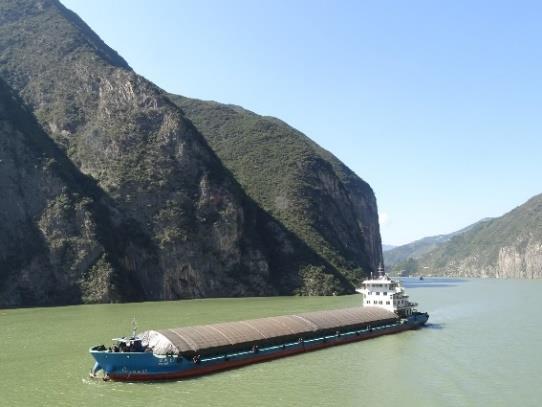
The locks’ operation is 22 hours per day 335 days per year, such is the volume of freight. A navigation rate of 84.13% is guaranteed, the authority says. As the locks are so busy, passenger and private boats are not permitted to use them; they have to use the boat lift – this takes about an hour to pass; the five-rises take 3 to 4 hours. 15 million tonnes pass the locks annually; however, the designed “single line working” capacity is 50mte (by 2030, as stated). Users of staircase locks in the UK will know the complexities of turning locks around between up and downhill traffic – it is no different here.
Before the dam and locks were built, only small cargo boats were able to pass the rapids in these gorges. The boats resembled traditional Chinese junks, which were hauled by manpower, with teams of men sometimes several dozen, called “trackers”. Each had his own line around him spliced into the main cable hauling the boat. The trackers, often naked as they said the ropes and rocks ripped any clothing, had in places to wade through the river and scramble over rocks, sometimes horizontal using their hands also to get sufficient purchase and pull. In the eye of society this was a very lowly type of job, was poorly paid and dangerous. The captain at the helm had to use all his skill and experience to not only avoid protruding rocks but also avoid whirlpools which could spell disaster for his boat and possibly the trackers. If a tracker lost his grip and slipped this could put extra strain on the others. This haulage practice continued until the 1980s, when motors started to make this way of life obsolete.
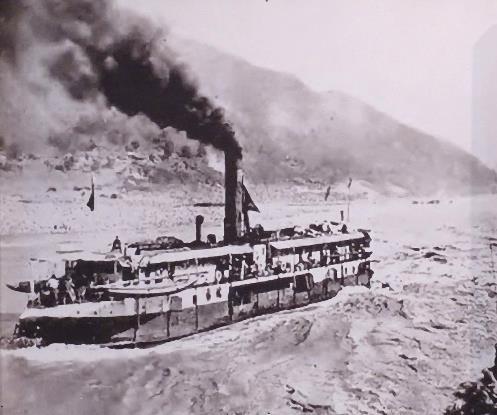
EU votes to future proof water transport
In a vote on a report covering the modal shift in freight from road to inland waterways and the greening of inland waterway transport and other matters, the vote of what appeared to be a cross party committee was totally in favour with 44 committee members voting with none against, with 3 abstentions.
In particular, the report highlighted the importance of tackling the energy transition in a cost-efficient and accessible way, while recognising the diverse range in types of vessels.
Some of the main points were:
• It welcomes the Commission’s intention expressed in the Sustainable and Smart Mobility Strategy to shift more goods from road to inland waterways and short-sea shipping. It recognises there is considerable untapped potential and scope for expansion of inland waterway transport
• Recommends the regular investment in expanding, updating and upgrading the physical and digital infrastructure of inland waterways, such as locks, bridges and the interoperable deployment of digital technologies across borders, enabling qualitative navigability and facilitating the modal shift to water
• The necessity for clean alternative fuels with alternative fuel infrastructure and propulsion methods for shipping
• Needs readily deployable options to reduce inland navigation emissions, including bridging fuels and transitional systems – energy transition in inland navigation is key to attaining the climate-neutral agenda by 2050
• With a lack of market-ready climate-neutral solutions, authorities should capacity-build funding in order to help the sector get access to funding, aiming towards climate neutrality
• Incentivising research and development projects is required for fuel and technologies that considerably reduce the impact on climate and the environment, to rapidly upscale fleets and build up supply chains and economies of scale
• The Commission should therefore, develop a realistic roadmap to further reduce pollutants and greenhouse gas emissions in order to achieve a decarbonised inland waterway sector, while safeguarding competitiveness, reliability and safety
• It underlined the particular role that inland waterways should play in the EU Hydrogen Strategy with clean fuelling of inland waterway transport with more efficient distribution of hydrogen along the EU’s transport networks and industry clusters
• The energy transition to climate neutrality is a technological and financial challenge for the inland navigation sector, which requires appropriate support; the Recovery and Resilience Facility (RRF) should be seized by Member States as a unique funding opportunity for inland waterways.
We wish them well in realising these good strategies. The Seine-Nord Canal as reported in the previous CBOA News would seem like an excellent example of a bold plan for a major improvement and shipping capacity upgrade across northern Europe. If the UK could effect a similar scheme and scaled appropriately, particularly where sea ports are connected, it would be a major step forward in dealing with the similar issues with energy and modal shift away from road transport dependence.
CBOA for Members
Inland Waterways Freight Operating Company Survey
We would be most grateful if you could spare some time to complete the online survey using the link provided below. https://freeonlinesurveys.com/s/8gULrHfz
The Inland Waterways Association Freight Group (IWA FG) has been asked to provide feedback to the Department for Transport (DfT) regarding water freight grants such as Freight Facilities Grant (FFG) and the Modal Revenue Support (MSRS) and why these have not been taken up by inland waterways freight operators. In order to provide an informed response to the DfT the IWA FG is trying to establish the shape and size of the UK's Inland Waterways Freight Carrying Sector with the objective of giving accurate and up-to-date feedback to Government.
All the information provided will remain confidential and individual company details will remain anonymous. Only aggregated data will be provided to Government on the shape and size of the Inland Waterways Freight sector.
CBOA News distribution
We are currently examining ways of how we might reduce the costs of distributing the CBOA News and make the process more efficient, mainly concerning the current free issue of the CBOA News to prominent and influential people in relevant organisations, as a publicity/promotional tool.
If anyone – CBOA members or otherwise – would prefer to have the electronic PDF version instead of the printed form, please advise us via info@cboa.org.uk. Naturally, we will continue to post copies to all CBOA members if we do not hear otherwise.
MCA ML5 medical for skippers
A CBOA member has recently recommended the firm D4 Medicals for the ML5, currently charging £75. D4 Medicals principally cover drivers’ medicals and operate from a number of locations inland some at or near towns on the canal system and rivers. Their website has a map so you can select your location. D4 Medicals advise that the ML5 cannot yet be booked on their website, so anyone wishing to book/request more information can call them on 0300 30 30 668 https://d4drivers.uk/locations/
As mentioned in previous CBOA News issues, Just-Health also offer this service https://just-health.co.uk/seafarers-medical-ml5/ 01282 936900.
These two providers can offer the medical at often a lower cost than a local GP. CBOA cannot recommend either provider and this is not an endorsement. A regularly updated countrywide list of MCA approved doctors can be found at https://www.gov.uk/government/publications/mca-approved-doctors-uk-based.
Committee Profile – Tim West, Vice Chairman
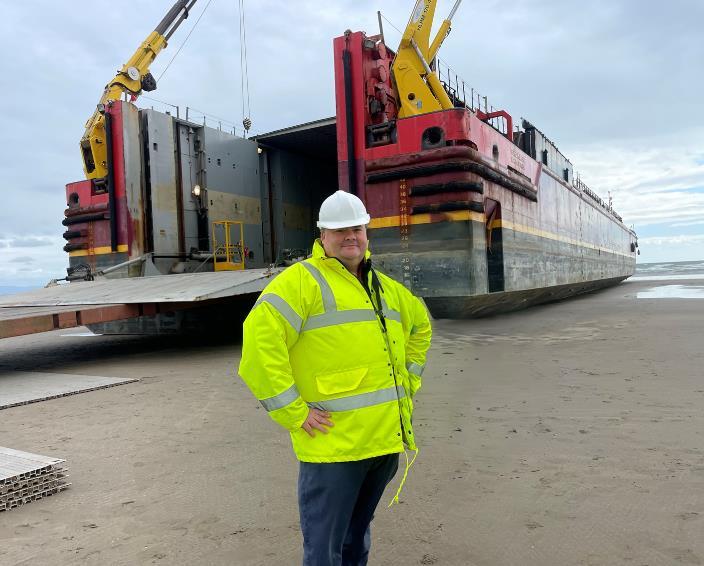

Tim is a Director of Wynns Group of companies. Wynns Ltd, are the UK's leading provider of independent advice on the movement of abnormal indivisible loads Robert Wynn & Sons Ltd own and operate specialist heavy lift barges carrying the largest and heaviest abnormal indivisible loads; these operate in and around the UK coast and waterways and across to the continent.
Tim joined Wynns in 1999 following a conversation with Managing Director Peter Wynn in their local rugby club in Staffordshire!
Initially brought in for the afternoon to provide his thoughts and suggestions regarding a Freight Facilities Grant application that was being considered, Tim has now been with Wynns for nearly 25 years. Having gained a degree in politics and then worked as a student officer at the University of Portsmouth, Tim’s role at Wynns initially focused on research and corporate affairs, spending considerable time working with others on what was to become the largest inland waterway Freight Facilities Grant award given by the Department for Environment Transport and the Regions. (Remember them?!)
In November 2000 the newly re-established Robert Wynn & Sons were awarded £8.5m to design and build two vessels; a “Multi-Purpose Pontoon”, the Terra Marique and to convert a former inland tanker barge the Inland Navigator to facilitate the Government’s policy to reduce the road milage travelled by the largest and heaviest abnormal indivisible loads by maximising the use of inland waterways, beach landings and non-traditional ports.
It soon became apparent to Tim and his colleagues that in order to make a success of their vessels’ operation they would have to take proactive role in stakeholder engagement. Their first thought was to join the trade association representing their industry which was of course the CBOA, so after a few exchanges of emails and phone calls Tim was dispatched to the Boat Inn in Stoke Bruene to attend a CBOA meeting and within a few months was asked to join the committee.
Over 20 years later Tim is still a CBOA committee member having been responsible for Government liaison for most of that time and more recently taking on the role of Vice Chairman.
Due to the role Tim fulfils as his “day job”, he has been able to take an active role in engagement with stakeholders, which can be categorised as “banging the drum” for the cause of water freight. This has resulted in Tim being invited to speak at conferences, attend working groups, provide evidence written and verbal to Parliamentary Select Committees and provide responses to many consultations and initiatives that have sought to encourage modal shift onto the UK commercial waterways.
Most recently Tim has become an active member of Logistics UK’s Water Council & Inland Waterway Freight Sub Group, the Thames Estuary Growth Board Light Freight Steering Group and represents freight on the Council of the Canal and River Trust. When time allows away from the heavy haulage and waterborne freight, Tim is heavily involved in his local rugby club of Eccleshall RUFC, occasionally putting his boots on to make the numbers up on a Saturday.
CBOA officer contacts
Chairman: Lee Wilshire
Email: lee.wilshire@cboa.org.uk
Mob: 07970 704532
Vice Chairman Tim West
Email: t.west@cboa.org.uk
Tel: 01785 850411
Treasurer Tony Seddon
Email: t.seddon@cboa.org.uk
Mob: 07854 226251
Secretariat Becky Clutton
Seddon Management Services
Email: info@cboa.org.uk
Mob: 07923 255086
Stoppages & Maintenance Brian McGuigan
Email: b.mcguigan@cboa.org.uk
Mob: 07791 345004
Parliamentary, Regional and Local Government Matters
Tim West
Email: t.west@cboa.org.uk
Tel: 01785 850411
Research Officer Chris Poole
Email: c.poole@cboa.org.uk
Mob: 07733 004258
European Representative Paul Ayres
Email: paul_ayres@outlook.com
Phone: 07802 606545
Scotland Representative Jonathan Mosse
Email: j.mosse@cboa.org.uk
Phone: 07788 974164
CBOA NEWS
Views expressed are not necessarily those of CBOA.
Editor: Richard Horne
Email: r.horne@cboa.org.uk
Tel: 01252 844259
Printer: iC Printing Services
Previous CBOA News issues can be viewed on the CBOA web site www.cboa.org.uk
Issues of CBOA News, either printed or PDF file can be obtained by members or non-members on request from info@cboa.org.uk
Please advise if would prefer to have an electronic PDF version of CBOA News instead of the printed form.
General Data Protection Regulations 2018 CBOA membership details are held on a computerised database under the terms of the General Data Protection Regulations. Your details will not be disclosed to other members or to parties outside the Association without your express permission.
North West Representative Liam Hewlett
Email: l.hewlett@cboa.org.uk
Mob: 07748 958303
Freight Representative (North) Ken Morris
Email: megmorris2903@gmail.com
Tel: 01829 752763
West Midlands Representative Bernard Hales
Email: b.hales@cboa.org.uk
Mob: 07860 308973
East Midlands Representative Andy Rothen
Email: info@rothenworkboats.co.uk
Mob: 07903 560785
South West Representative Shaun Dallisson
Email: s.dallisson@cboa.org.uk
Mob: 07799 874466
Southern Representative Lee Wilshire
Email: Lee@whhbarges.co.uk
Mob: 07970 704532
Greening Water Logistics
Bernard Hales/Paul Ayres/Jonathan Mosse (contacts as above)
Planning Matters & CBOA News Editor Richard Horne
Email: r.horne@cboa.org.uk
Mob: 07792 149942
CBOA Membership Dominique Birks
Robert Wynn & Sons Ltd.
Email: dominique.birks@robertwynnandsons.co.uk
Tel: 01785 850411
General enquiries: info@cboa.org.uk
Leeds & Liverpool Canal 250th anniversary celebrations
The CRT are holding a celebration of the 250th anniversary on 19 October at Burscough Wharf, of the opening of the Leeds & Liverpool Canal between Wigan and Liverpool
As well as creative and engaging activities for all the family, CRT are featuring historic boats, particularly Leeds and Liverpool craft with a past connection with the waterway. Acknowledging that the canal was a vital part of a commercial thoroughfare transporting goods across the Pennines to the North Sea, much of the celebration is that the canal still exists in its entirety as a through route today, excepting some arms and branches.
As a barge canal, CBOA sees that this focus on the canal with its freight craft might encourage some use of the canal for freight, perhaps on a local basis. Waste, aggregates and recycling might be an example of a suitable cargo; some of this is currently operating on the London canals. The Leeds & Liverpool Canal certainly passes through built up areas on the west side where this might be feasible. Contact: james.long@canalrivertrust.org.uk
President: Mike Garratt Vice Presidents: Dr. David Quarmby CBE, John Dodwell
